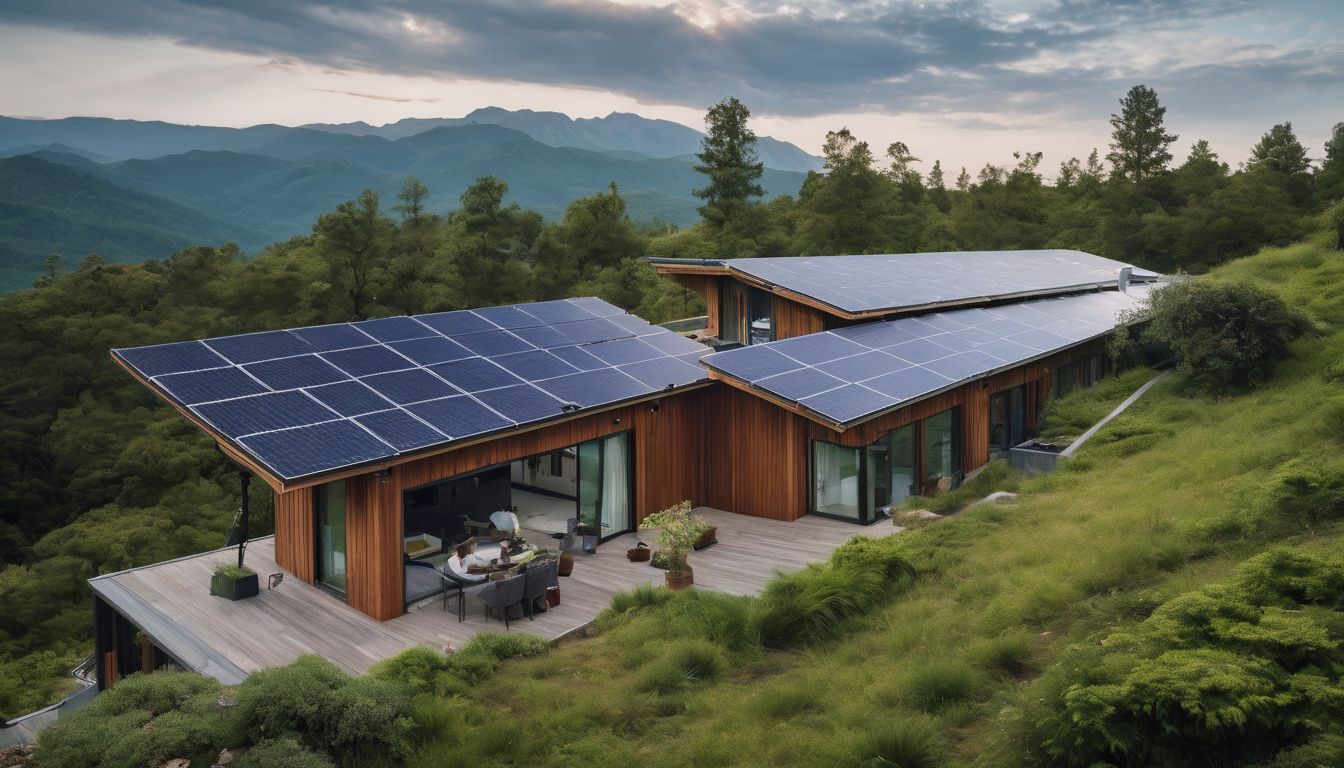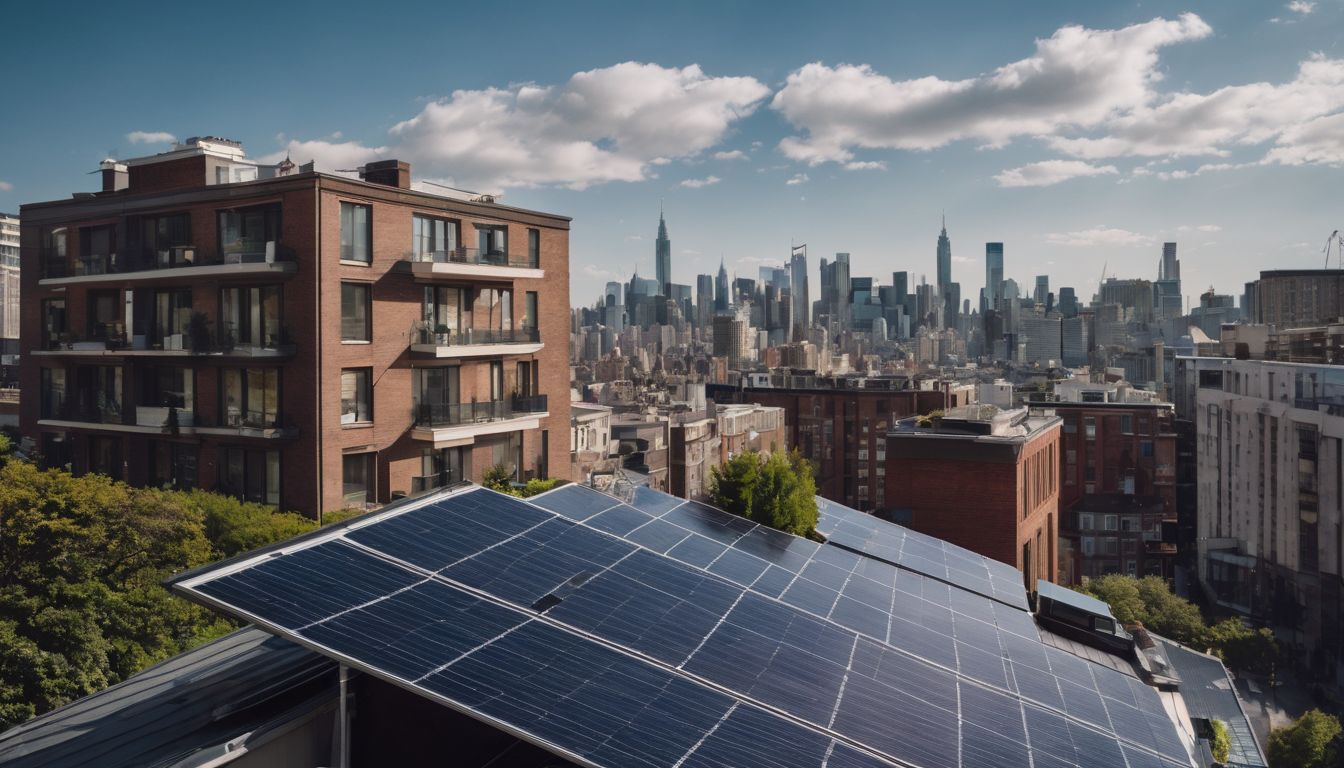Striking the right balance between preserving our historic buildings and embracing renewable energy is no easy feat. Yet, a growing number of heritage properties are turning to solar panels as a solution.
Our article will delve into how these iconic structures can benefit from modern sustainability while maintaining their timeless charm. Keep reading to discover how history meets high-tech in harmony.
Key Takeaways
- Solar panels offer a way for historic buildings to cut energy costs and lower their carbon footprint while maintaining their heritage.
- Researching local regulations, working with preservation commissions, and finding tax incentives are essential steps before installing solar panels on listed properties.
- Advanced technologies in solar panel design allow for discreet installation that respects the historic character of buildings.
- Rising energy costs make renewable solutions like solar power increasingly important to preserve historic sites sustainably.
- Proper planning ensures the structural integrity of historic buildings is not compromised when retrofitting them with solar panels.
The Debate Over Installing Solar Panels on Historic Buildings
While the benefits of solar power for historic buildings are clear, there is also a concern about preserving their historic character. Factors such as proper planning and placement of panels, impact on the structure of the building, and maintenance must be considered before installation.
Benefits of solar power for historic buildings
Solar power breathes new life into historic buildings, slashing energy costs substantially. By embracing renewable energy, these structures can reduce their carbon footprint, contributing to environmental conservation efforts.
Retrofitting historic properties with solar panels ensures that they remain economically viable and sustainable for years to come. This modern upgrade aligns with the growing need for sustainable architecture while respecting the building’s historical value.
Owners of listed buildings who install photovoltaic systems may benefit from tax credits and incentives aimed at preserving our architectural heritage through green technology. Solar energy provides a reliable power source, reducing dependence on fossil fuels and promoting self-sufficiency.
Such installations must be done within the guidelines stipulated by preservation bodies like the National Register of Historic Places to ensure that the unique character of these buildings is maintained even as they step into a more sustainable future.
Concerns about preserving historic character
Incorporating solar panels on historic buildings raises concerns about preserving the authentic character of these structures. Balancing the integration of modern renewable energy solutions with the preservation of historical architecture is crucial.
It requires careful planning and considerations to ensure that the visual integrity and unique features of listed buildings are maintained while harnessing sustainable energy sources.
Preservation commissions play a pivotal role in addressing these concerns, emphasising discreet placement of panels and adherence to guidelines for maintaining the historic fabric of buildings.
By working collaboratively with such bodies and leveraging advancing technology, it is possible to integrate solar power into historic districts without compromising their aesthetic value.
Factors to Consider Before Installing Solar Panels on Historic Buildings
Before installing solar panels on historic buildings, it is important to thoroughly research regulations and policies regarding the installation of solar panels on listed or historic structures.
Proper planning and placement of the panels are essential to minimise visual impact and preserve the building’s historic character. Additionally, careful consideration should be given to the impact on the structure of the building and ensuring proper maintenance and care for the roof.
Researching regulations and policies
When researching regulations and policies for installing solar panels on historic buildings, it is crucial to consult with local preservation commissions or authorities. Review the listed building regulations and Secretary of the Interior’s Standards to ensure compliance with historical preservation guidelines.
Understanding the specific requirements and limitations will help in navigating the process smoothly.
Consider exploring potential historic tax credits or incentives that may be available for integrating sustainable energy solutions into listed buildings. Take note of any solar panel installation guidelines set forth by conservation agencies to ensure that the installation aligns with energy efficiency and building conservation standards.
Proper planning and placement of panels
When installing solar panels on historic buildings, it is crucial to carefully plan and position the panels to ensure minimal visual impact. Researching regulations and policies is essential, as well as considering the impact on the building’s structure.
Proper placement of photovoltaic panels can help to maintain the historic character of the building while harnessing renewable energy. Additionally, working with preservation commissions and discreetly integrating solar panels can minimise any negative effects on the building’s aesthetics.
Once all these factors are considered, it becomes easier to seamlessly blend modern technology with historic buildings for sustainable preservation without compromising their unique charm.
Impact on the structure of the building
When considering the impact on the structure of the building, it’s crucial to assess the potential effects of installing solar panels. The additional weight of the panels must be carefully evaluated to ensure that the structural integrity of historic buildings is not compromised.
Moreover, proper installation and securing methods are essential to prevent any damage or alterations to the building’s original features. Additionally, conducting regular inspections and maintenance can help safeguard against any potential issues arising from solar panel integration.
The placement and installation of solar panels should be approached with a meticulous focus on preserving the architectural and historical significance of listed buildings.
Maintenance and care for the roof
When it comes to maintaining solar panels on historic buildings, regular inspections and cleaning are crucial. By keeping the panels free of debris and ensuring that the roof remains in good condition, you can maximise energy production and prevent any potential damage to the building’s structure.
It is important to consult with professionals for periodic maintenance checks and repairs, as well as staying informed about any specific care requirements for historic roofing materials.
Following these steps will help preserve both the historical integrity of the building and its sustainable energy capabilities.
Regular upkeep of solar panels on historic structures not only ensures optimal performance but also contributes to the conservation of these significant landmarks. By incorporating routine inspections into your overall maintenance plan, you can safeguard both the structural integrity of the building and its contribution to renewable energy efforts.
Overcoming Challenges and Addressing Concerns
Proper planning and discreet placement of solar panels can help to address concerns about preserving the historic character of buildings, while working with preservation commissions can ensure that the integration of renewable energy technology aligns with conservation objectives.
Read more about the debate over installing solar panels on historic buildings in our blog.
Discreet placement of panels
When considering historic buildings, discreet placement of solar panels is crucial. Thoughtful integration can be achieved without compromising the visual integrity of these structures.
The careful positioning of panels on less visible areas such as rear or flat roofs allows for energy generation while preserving the building’s character and appearance.
The sensitive installation of solar panels on historic properties respects their architectural significance. Integrating renewable energy solutions should be planned in a way that harmonises with the building’s aesthetic, ensuring that conservation and environmental considerations are equally prioritised.
Working with preservation commissions
When working with preservation commissions, it is essential to engage in open communication and collaboration. Seek guidance and approval before installing solar panels on historic buildings.
Respect the guidelines and regulations set forth by the commission, ensuring that the integrity of the building’s historic character is preserved. By fostering a constructive relationship with preservation commissions, environmentally conscious individuals can contribute to both sustainable energy practices and the conservation of historic properties.
It’s vital to involve preservation commissions early in the planning process. This proactive approach enables thoughtful consideration of how solar panel integration can align with preservation goals while promoting energy efficiency in historic buildings.
The role of technology in preserving historic character
When considering the preservation of historic character, technology plays a vital role in finding innovative solutions. Advanced solar panel integration technology allows for discreet placement on rooftops, minimising visual impact while still harnessing renewable energy.
This careful balance between preserving the historic charm of buildings and embracing modern sustainable practices is made possible by advancements in solar panel design and installation techniques.
In addition to discreet placement, new technological developments enable solar panels to be more compatible with the unique architectural features of historic buildings. These advancements ensure that the installation process respects the building’s structural integrity and aesthetic appeal.
The Growing Importance of Renewable Energy in Historic Preservation
Historic preservation is facing increasing challenges from rising energy costs, making the integration of renewable energy sources like solar power essential for long-term sustainability.
Solar panels offer a viable solution to protect and maintain historic buildings while also reducing their environmental impact.
The impact of rising energy costs on historic buildings
Rising energy costs pose a significant challenge to historic buildings, often straining limited preservation budgets. Balancing the need for modern amenities with the preservation of historical character can be particularly challenging when facing increasing utility expenses.
The integration of renewable energy sources like solar power can provide a sustainable solution, helping protect and maintain these treasured sites while reducing long-term operational costs.
Solar power presents an opportunity to alleviate the financial burden imposed by escalating energy expenses. Implementing solar panels on historic buildings not only offers a way to combat rising utility bills but also contributes to environmental conservation efforts in preserving our cultural heritage.
The potential for solar power to protect historic sites
Solar power presents a valuable opportunity to safeguard historic sites by reducing their reliance on non-renewable energy sources. Integrating rooftop solar panels into listed buildings can help preserve their unique character and heritage while also contributing to environmental conservation efforts.
By harnessing the sun’s energy, these buildings can decrease their carbon footprint and become more self-sufficient, ensuring that they continue to stand for future generations.
Moreover, embracing solar energy in historic preservation not only demonstrates a commitment to sustainability but also serves as an innovative solution to mitigate the impact of rising energy costs on these iconic structures.
Conclusion
In conclusion, installing solar panels on historic buildings requires careful consideration and planning. Preservation commissions and technology play significant roles in finding solutions to the challenges of preserving the historic character while benefiting from renewable energy.
The growing importance of renewable energy emphasises the potential for solar power to protect and sustain historic sites against rising energy costs. Retrofitting historic buildings with solar panels can contribute to both environmental conservation and the preservation of our heritage.
FAQs
1. Can you install solar panels on historic or listed buildings?
Yes, it is possible to place solar panels on historic or listed buildings but often requires special permission and careful planning to ensure preserving the building’s character.
2. How does retrofitting work with preserving historic buildings?
Retrofitting historic buildings for solar panels involves adapting new technology whilst maintaining the structure’s original features and heritage value.
3. Are there benefits to adding solar panels to a preserved historical building?
Adding solar panels can modernise historic buildings in an eco-friendly way, potentially lowering energy costs and improving sustainability without harming their historical significance.
4. Do property owners get tax credits when restoring historic buildings with green technology like solar panels?
Owners may receive tax credits for historically accurate restoration that includes environmentally friendly upgrades such as installing solar panels, depending largely on local regulations and available schemes.





